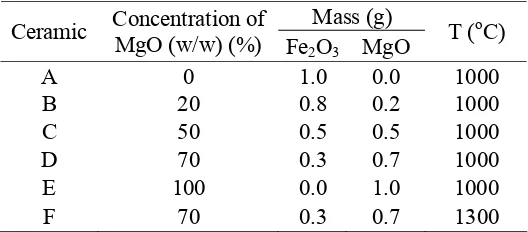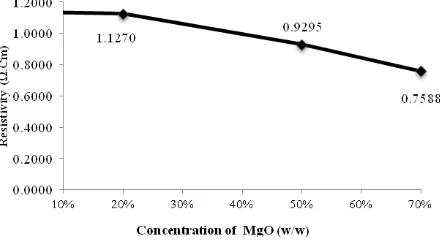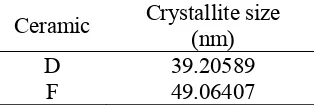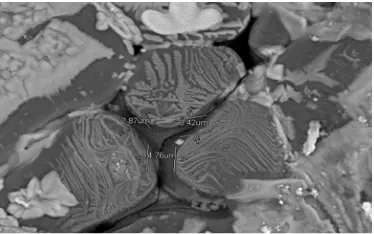The journal homepage www.jpacr.ub.ac.id ISSN : 2302 ‐ 4690
103
Fabrication of Oxide Ceramic MgFe
2O
4Using Iron Oxide
Isolated from Lapindo Mud as a Raw Material
Riska Yudhistia,*1 Rachmat Triandi Tjahjanto,1 Akhmad Sabarudin1
1
Departement of Chemistry, Faculty of Science, Brawijaya University Jl. Veteran Malang 65145, East Java, Indonesia
*
Corresponding Author: [email protected]
Received 23 July 2013; Accepted 12 September 2013
ABSTRACT
The quite high content (28.8%) of iron oxide (Fe2O3) in Lapindo Sidoarjo`s mud promotes as a potential raw material for fabrication of oxide ceramics. The preeminence magnetic properties of iron oxide materials have led to be widely used for preparation of noteworthy product i.e semiconductor ceramics. However, the high band gap of iron oxide results in high resistivity, limiting its application as semiconductor ceramics. The addition of other oxides to iron oxide is able to reduce the energy gap of resulted oxide ceramics. Accordingly, in this study, MgO is added to Fe2O3 isolated from Lapindo mud for preparation of the oxide ceramic MgFe2O4. The products are characterized, which include crystal structure, crystal size and resistivity. It was found that the addition of MgO decreased the volume fraction of spinel structure formation, the average of crystal size, and the resistance value. The ratio MgO/Fe2O3 of 3:7 and a sintering temperature of 1300oC show the optimum composition for fabrication of MgFe2O4 with the volume fraction of 0.72 and the crystal size of 49.06 nm as characterized by XRD.
.
Keywords: Lapindo mud, Fe2O3, MgO, MgFe2O4, oxide ceramics.
INTRODUCTION
Nowadays, the iron oxide materials come into great popularity on the research activities especially in the fields of material science and technology. Due to the magnetic properties preeminence, iron oxide materials have been widely used for many products such as ceramics, inks, catalysts, thin films, nano-particles technological and semiconductor ceramics. Solikha et al [1] used a semiconductor ceramic as a sensitive gas sensor in the environment. However, a semiconductor ceramic made of iron oxide as a raw material possesses high resistivity caused by the high energy gap (3.1 eV) of iron oxide itself [2], which may confine for further applications in this field.
The addition of copper oxide (CuO) to the iron oxide (Fe2O3) in the fabrication of
ceramic oxide semiconductor CuFe2O4, produce ceramic CuFe2O4 with the energy gap value
of 2.4 eV. In this work, ceramic oxide CuFe2O4, whose has spinel structure, is sintered at
1000 and 1100 °C for one hour [3]. Such results proved that the mixing other oxides with iron oxide can decrease energy gap ferrite compounds to be used as the raw material of the ceramic oxide semiconductor. Similarly, magnesium oxide can be added to iron oxide to form oxide ceramic of MgFe2O4 with energy gap of 2.18 ev [4].
Lapindo Sidoarjo’s mud consist of some major oxides, such as 40.1% SiO2, 28.8%
Fe2O3, and 15% Al2O3 [5]. Several studies have been conducted to isolate silica (SiO2) and
The journal homepage www.jpacr.ub.ac.id ISSN : 2302 ‐ 4690
104
and silica aerogel [6]. However, to best of our knowledge, there is no research dealing with isolation of Fe2O3 from Lapindo mud to be utilized as a raw material for fabrication of some
valuable materials with can increase its economic value. Therefore, in this study, Fe2O3 from
Lapindo mud is isolated using the acidic method, and subsequently applied as a raw material for the formation of oxide ceramic MgFe2O4 after reacted with MgO. The ratio of Fe2O3 to
MgO as well as sintering temperature is studied in detail. The resulted oxide ceramic MgFe2O4 is characterized which includes the measurement of spinel volume’s fraction,
crystal size, morphology, and resistivity.
EXPERIMENT
Chemicals and instrumentation
Some chemicals used in this experiment are HCl 37% ρ = 1,19 g/mL, HNO3 66% ρ =
1,51 g/mL, MgO and NH4OH 21% . All chemicals were of analytical grade and purchased
from Merck (Germany).
The sample in this study is a chunk of Lapindo's mud and mud liquid which was taken in the Porong subdistrict of Sidoarjo Siring with coordinates of 07o 31.480’ LU and 112o 42.274’ LS,is 2.7 meter from the edge of the embankment and the distance from the center of the hot blast of 1.5 km and a depth of 75 cm. Prior to use, Lapindo mud sample is dried in an oven at 110°C for 24 hours. Then, the sample is finely crushed in a mortar and stored in a sealed container. The metal contents in dried Lapindo mud are analyzed using X-ray Fluorescence (XRF).
The instrumentations used in study include Oven Fisher Scientific 655 F, Furnace Nabertherm N-31 model, German; Pressing tools Paul Otto Weber Gmbh, German, multimeter Sanwa CD800a, XRF PANanalytical type Minipal 4, United States; Scanning Electron Microscope (SEM) Tabletop Microscope TM3000 type Hitachi, Japan; XRD X’pert type Philips, The Netherlands.
Procedure reaction
Isolation of Fe2O3 form Lapindo
A 10-mg of dried sample is dissolved in 20 ml of aqua regia. After agitation and heating the sample for 1 h, the obtained precipitate is separated by filtration. Then, the filtrate is added with excess amounts of NH4OH to precipitate Fe(OH)3. After filtration, Fe(OH)3 is
dried at 110 °C to form Fe3O4. The latter iron oxide is calcinated at 600 °C for 1 h to form
Fe2O3, which then analyzed by XRF to measure the iron oxide content.
The journal homepage www.jpacr.ub.ac.id ISSN : 2302 ‐ 4690
105
Fabrication of MgFe2O4 ceramics
Magnesium oxide is added into Fe2O3 at various concentration of 0, 20, 50, 70 and
100% by weight (w/w), with a total weight of ceramic MgFe2O4 to be made as much as 1 g.
Ceramic powder composition is shown in Table 1. The mixing is performed in mortar and stirred for 1 h. The pressing process is performed in uniaxial with a compressive load of 2 × 103 kg/cm2 to produce ceramic pellets. Then raw ceramic pellets is sintered at 28 - 1000 °C (and 28 - 1300 °C) for 2 h. The resulted ceramic is characterized, which include the measurement of spinel volume’s fraction, crystal size, resistivity and micro-picture (morphology).
RESULT AND DISCUSSION
Isolation of Fe2O3 of mud Lapindo with acidic method
The principle of isolation of iron(III) oxide (Fe2O3) with acidic method is to separate
the Fe(III) from samples of sludge extraction with Lapindo using acid solution, then it is conducted the precipitation of Fe(III) in the form of hydroxide (Fe(OH)3) using a solution of
ammonium hydroxide. Calcination temperature affect formation of structure of Fe2O3.
Temperatures above 500 °C produced the Hematite (α-Fe2O3) which is an isostructural of
corundum [8]. Then iron oxide obtained is characterized using XRF. Level of iron oxide obtained from this method as shown in Table 2.
Table 2. The analyze result of the content of metal
oxides (Si, Al and Fe) from acidic method using XRF.
Percentage (%) Sample
Al Si Fe Lapindo’s mud sample 13.00 38.20 32.60 Precipitation from the
result of Acidic Method 5.60 0.00 79.62
Characteristics of Ceramics MgFe2O4
In this study, MgFe2O4 ceramics are made using raw materials of Fe2O3 which is the
result of the isolated Lapindo’s mud, while MgO is analytical grade. To determine the optimum composition in the fabrication of ceramics, characterization MgFe2O4 then it is
performed to look at the most optimum results. The characterizations were performed such that the calculation of the volume fraction of spinel structure formation, crystal size and resistivity of ceramics at each composition.
To find out how many spinel structure is formed on the ceramic structure MgFe2O4
made, it is performed an analysis using XRF. From the analysis, it can be calculated volume fraction of the spinel structure ceramics B, C and D based on equation 1 [9], and obtained the results as shown in Table 4.
The journal homepage www.jpacr.ub.ac.id ISSN : 2302 ‐ 4690
106
Where MgFe2O4 (220) is the peak intensity of the (220) of MgFe2O4 and Fe2O3 is the
peak intensity of the (104) of Fe2O3.
Table 3. Intensity ratio and the volume fraction of the ceramic spinel formation MgFe2O4.
Ceramic Rx
(Intensity ratio)
Α
(Volume fraction)
B 0.1272 0.0634
C 0.2476 0.1191
D 0.2495 0.1201
Based on Table 3 it can be shown that the more increased volume fraction and the more MgO’s concentration used.
The resistivity is represented by the symbol ρ and defined as a measure of whether or not the electrons to move easily within a material. The result of resistivity calculation’s characteristic shows that the resistivity of the ceramic MgFe2O4 decreases as shown in Figure
1.
Figure 1. Curve concentration MgO vs resistivity of ceramics MgFe2O4
Resistivity decreases with the increasing of MgO’s concentration used due to the increasing concentration of MgO is added, the formation MgFe2O4 gets increased. This is proven by the
result of the fraction volume’s calculation of spinel is also increasing. Magnesium oxide is an oxide that do not have a free electron. This means that MgO in the solid state can not conduct electricity. This causes that the concentration of MgO ceramics E with 100% (w/w) resistance can not be measured.
Crystal size of the ceramic MgFe2O4 can be calculated based on the Debye Schererr
equation based on data analysis using XRD. The result of calculations using the crystal size Debye Schererr modification equation is shown in Table 5. Its equation is presented in equation 2 [10].
(Equation 2)
The journal homepage www.jpacr.ub.ac.id ISSN : 2302 ‐ 4690
107
Half Maximum) in units of radians and ө is bragg angle. By plotting ln 1/cosө values on the x-axis and y-axis ln β, the intercept obtained a value of ln (K λ / L), and the size of the crystal (L) can be determined.
Table 4. Crystal sizes of MgFe2O4 ceramic B, C and D
Ceramic Average crystal size (nm) B 87.80576 C 39.58408 D 39.20589
Based on Table 4 it can be shown that the average size of crystallite on ceramics MgFe2O4 get decreased with the increasing concentration of MgO added. This is due to that
the increasing number of MgO added in the ceramic matrix is MgFe2O4 whereas magnesium
oxide is the second phase. Magnesium oxide has a relatively small size compared to the oxide Fe2O3 and MgFe2O4. Therefore, with the increasing addition of MgO in the fabrication of
ceramics MgFe2O4, MgO crystal size affects the value of the average crystal size ceramic
MgFe2O4 is getting smaller.
Based on the result calculation of XRD and resistivity of the data is showed that the optimum composition is found in concentrations of 70% MgO (the biggest volume fraction, average sized crystall and the smallest resistivity).
Effect of Sintering Temperature
Value of the volume fraction of the ceramic spinel MgFe2O4 sintered at 1000 °C
(Ceramic B, C and D) are still too small, this is allowed since the used sintering temperature which is not high so the forming of the spinel’s new structure cannot move optimally. Therefore the sintering process is performed at a temperature of 28 °C - 1300 °C and then held for 2 hours at a temperature of 1300 oC. It performed on the pellets with 70% MgO concentration. MgFe2O4 ceramics obtained from the sintering process (Ceramic F)
characterized to determine the character of the ceramic.
Table 5. Comparison of the average crystallite size ceramic D and F.
Ceramic Crystallite size (nm)
D 39.20589 F 49.06407
Based on the results of the characterization of ceramics F using XRD, obtained spinel volume fraction is amount 0.72. This value is much greater than in the ceramic D (Table 5). It means that the sintering temperature increases the formation of spinel structure in the forming of MgFe2O4. At temperatures 1000 °C, a used mixture of iron oxide and magnesium
oxide is a few parts which have formed MgFe2O4’s spinel structure. In the sintering process
The journal homepage www.jpacr.ub.ac.id ISSN : 2302 ‐ 4690
108
fraction of the ceramic spinel F is greater than the ceramic D. Temperature also affects the average crystal size of the resulting ceramic MgFe2O4 as shown in Table 5, which shows the
comparative crystallite sizes of ceramic D and F.
Average crystal size on ceramics F is increased compared to ceramic D. Formation of spinel structure affects the average crystallite size on ceramics MgFe2O4. Based on the
calculation it is known that the ceramic volume fraction F has a value greater than ceramic D. It means that the ceramic D, MgFe2O4 is formed more. Magnesium ferrite has relatively
larger size, with the more formation of ceramics MgFe2O4 F causes an increase in the average
sized crystal.
Resistance measurement on ceramics F is also performed, but the resistance value can not be measured directly. Heating the ceramics is also conducted with the expectation that the increase of temperature can improve the mobility of the electron. So, it can analize the electricity and the resistance of the ceramic cannot be measured. This is possible because the energy gap of the resulting MgFe2O4 still too width.
The density of crystalline structure can also inhibit the mobility of electrons, thus affects its resistance. This is supported by the calculation of shrinkage of the ceramic fuel MgFe2O4. Loss of mass and volume values on ceramic D of 29.4 and 31%, whereas the F
ceramic mass and volume shrinkage of 64.40 and 76.30%.
At the sintering temperature 1000 °C, exsiccate fuel values of ceramic is still smaller than the temperature of 1300 oC. It means that the crystal structure of the ceramic at 1000 °C is not too tight. So the electron mobility is quite high and can be measured. At temperature 1300 oC while the treatment is more tightly structured so that the low electron mobility so the resistance can not be measured directly. It is also supported by data of the calculation result of both ceramics, the density of ceramics at the sintering temperature of 1300 °C is greater (2.4038 g/cm3) than at 1000 °C (1.3453 g/cm3)
Figure 2. Micro image MgFe2O4 at 3000x magnification.
The surface area of contact between the electrode and ceramic MgFe2O4 can also
affect the resistance measurement. Electrode coatings on ceramic F can increase the interfacial surface area contact between the MgFe2O4 with a multimeter measuring
instrument. On the ceramic F, it is performed the micro picture analyze by SEM. Based on the imaging, there are a sphere with the various sizes as shown in Figure 4. Grain size of the ceramic MgFe2O4 are variability caused by the mixing process Fe2O3 and MgO aren’t
The journal homepage www.jpacr.ub.ac.id ISSN : 2302 ‐ 4690
109
CONCLUSION
Based on the results of this, the conclusion is that after the magnesium oxide into iron oxide sintering then it is performed at a temperature of 1300 °C to produce ceramic oxides with spinel structure. The optimum composition of the ceramic forming MgFe2O4 the
addition of MgO concentration of 70% by spinel volume fraction values formed by 0.72, but the value of the resistivity can not be measured directly. The micro structure of ceramics MgFe2O4 spheres with the various sizes.
ACKNOWLEDGMENT
The first author would like to thank to Biro Perencanaan dan Kerjasama Luar Negeri
(BPKLN) Kemdikbud, which has provided an opportunity for the author to continue
postgraduate of Chemistry at Brawijaya University through the Fast Track Scholarship program.
REFERENCES
[1] Solikha, Wilda, Dani,Gustaman and Suhendi, Prosiding Semnas Sains Teknologi Nuklir
PTNBR-BATAN,Bandung, 2012, 325-328.
[2] Carter, Barry, M.G. Norton, Ceramics Material : Science and Engineering, 2007 Springer, Rusia.
[3] Wiendartun, Dani Gustaman S, J. Mat. Sci. Res., 2012, 1, 3, 70-75.
[4] Bangale, S.V, D.R Patil and S.R Bamane, Arch. App. Sci. Res., 2011, 3, 5, 506-513. [5] Putri, S.E, Studi Pembuatan Keramik Berpori Secara Gelcasting Menggunakan
Akrilamid Dengan Bahan Dasar Lumpur Lapindo, Jurusan Kimia FMIPA, Universitas Brawijaya Malang, Indonesia, 2012.
[6] Zaemi, Haris, Sintesis Aerogel Silika dari Lumpur Lapindo dengan Penambahan Trimetilklorosilan (TMCS), Jurusan Kimia FMIPA, Universitas Brawijaya Malang, Indonesia, 2013.
[7] Sodiq, M. Ja’far, Studi Sintesis Nanopartikel SiO2 dari Lumpur Lapindo, Jurusan Kimia
FMIPA, Universitas Brawijaya Malang, Indonesia, 2012.
[8] Cornell dan Schwertmann, The Iron Oxides, 2003, WILEY-VCH Verlag GmbH & Co. KgaA, Weinhwim.
[9] Paik, Jong-Gyu, Man-Jong Lee and Sang-Hoon Hyun, Thermochim. Acta, 2004, 425,
131-136.



